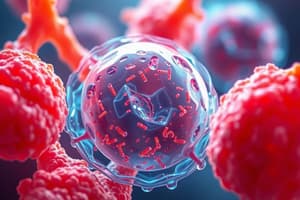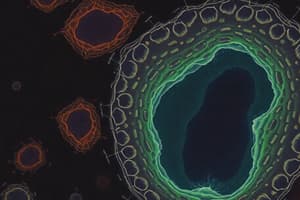Podcast
Questions and Answers
What is the primary function of albumin in blood?
What is the primary function of albumin in blood?
- To maintain osmotic pressure (correct)
- To provide energy
- To facilitate clotting
- To transport oxygen
Where does hemopoiesis primarily occur during the second trimester?
Where does hemopoiesis primarily occur during the second trimester?
- In the spleen
- In the bone marrow
- In the liver (correct)
- In the lungs
Which statement about leukocytes is correct?
Which statement about leukocytes is correct?
- They require plasma proteins for function
- They are spherical in blood and can become amoeboid after leaving blood vessels (correct)
- They are all motile in blood
- They have a longer lifespan than erythrocytes
What type of cartilage contains elastic fibers in addition to collagen type II?
What type of cartilage contains elastic fibers in addition to collagen type II?
Which type of bone marrow is filled with adipocytes and excludes hemopoietic cells?
Which type of bone marrow is filled with adipocytes and excludes hemopoietic cells?
How do neutrophils function in the immune response?
How do neutrophils function in the immune response?
Which of the following components comprises the extracellular matrix of cartilage?
Which of the following components comprises the extracellular matrix of cartilage?
What happens to yellow bone marrow under severe bleeding or hypoxia?
What happens to yellow bone marrow under severe bleeding or hypoxia?
What component of blood is involved in the initial response to form a clot?
What component of blood is involved in the initial response to form a clot?
What is a common shape of erythrocytes that aids in their function?
What is a common shape of erythrocytes that aids in their function?
What is the primary function of osteocytes in bone tissue?
What is the primary function of osteocytes in bone tissue?
What shape do osteoblasts adopt when they are actively synthesizing bone matrix?
What shape do osteoblasts adopt when they are actively synthesizing bone matrix?
What type of collagen makes up the organic components of bone?
What type of collagen makes up the organic components of bone?
What is a key characteristic of osteoclasts?
What is a key characteristic of osteoclasts?
What role does the periosteum play in bone structure?
What role does the periosteum play in bone structure?
How do osteocytes communicate with one another?
How do osteocytes communicate with one another?
What substance is primarily involved in the resorption process of bony tissue?
What substance is primarily involved in the resorption process of bony tissue?
What is the outer layer of bone tissue called?
What is the outer layer of bone tissue called?
What is responsible for the large size of osteoclasts?
What is responsible for the large size of osteoclasts?
Which statement accurately describes osteoblasts?
Which statement accurately describes osteoblasts?
What is the primary role of fibroblasts in connective tissue?
What is the primary role of fibroblasts in connective tissue?
Which type of epithelial tissue has a high mitotic index?
Which type of epithelial tissue has a high mitotic index?
What characterizes heterochromatin?
What characterizes heterochromatin?
What is the major reason for the poor regenerative capacity of cartilage?
What is the major reason for the poor regenerative capacity of cartilage?
What defines endocrine glands?
What defines endocrine glands?
What type of secretion involves the entire cell disintegrating to release its contents?
What type of secretion involves the entire cell disintegrating to release its contents?
What is the primary function of microvilli on epithelial cells?
What is the primary function of microvilli on epithelial cells?
What is the purpose of a fixative in tissue preparation?
What is the purpose of a fixative in tissue preparation?
What distinguishes parenchyma from stroma in an organ?
What distinguishes parenchyma from stroma in an organ?
How are tissues typically preserved in microscopic preparations?
How are tissues typically preserved in microscopic preparations?
Flashcards
Nucleus
Nucleus
A membrane-bound organelle containing genetic material (DNA) and involved in cell regulation, growth, and reproduction.
Lysosomes
Lysosomes
Membrane-bound organelles responsible for breaking down cellular waste and debris.
Heterochromatin
Heterochromatin
Dense, inactive form of DNA found within the nucleus.
Endoplasmic Reticulum (ER)
Endoplasmic Reticulum (ER)
Signup and view all the flashcards
Mitochondria
Mitochondria
Signup and view all the flashcards
Fixation
Fixation
Signup and view all the flashcards
Macrophage
Macrophage
Signup and view all the flashcards
Tissue embedding
Tissue embedding
Signup and view all the flashcards
Fibroblast
Fibroblast
Signup and view all the flashcards
Cartilage
Cartilage
Signup and view all the flashcards
Hyaline cartilage
Hyaline cartilage
Signup and view all the flashcards
Perichondrium
Perichondrium
Signup and view all the flashcards
Chondroblasts
Chondroblasts
Signup and view all the flashcards
Chondrocytes
Chondrocytes
Signup and view all the flashcards
Anaerobic Metabolism of Cartilage
Anaerobic Metabolism of Cartilage
Signup and view all the flashcards
Hemopoiesis
Hemopoiesis
Signup and view all the flashcards
Hematopoietic Stem Cells
Hematopoietic Stem Cells
Signup and view all the flashcards
Asymmetric cell division
Asymmetric cell division
Signup and view all the flashcards
Blood cell development
Blood cell development
Signup and view all the flashcards
Bone marrow
Bone marrow
Signup and view all the flashcards
What is bone tissue?
What is bone tissue?
Signup and view all the flashcards
What are osteoblasts?
What are osteoblasts?
Signup and view all the flashcards
What are osteocytes?
What are osteocytes?
Signup and view all the flashcards
What are osteoclasts?
What are osteoclasts?
Signup and view all the flashcards
What is the periosteum?
What is the periosteum?
Signup and view all the flashcards
What are perforating fibers?
What are perforating fibers?
Signup and view all the flashcards
What is endochondral ossification?
What is endochondral ossification?
Signup and view all the flashcards
What is the role of bone in mineral homeostasis?
What is the role of bone in mineral homeostasis?
Signup and view all the flashcards
What are the main components of bone tissue?
What are the main components of bone tissue?
Signup and view all the flashcards
How do osteocytes communicate with each other?
How do osteocytes communicate with each other?
Signup and view all the flashcards
Study Notes
Eukaryotic Animal Cells
- Eukaryotic cells have distinct membrane-bound organelles.
- Nucleus, lysosomes, and other organelles are membrane-bound.
- Nuclear chromatin and nucleolus are non-membrane bound.
- Heterochromatin is dense, inactive DNA.
- Endoplasmic reticulum (ER) is rough or smooth.
- Mitochondria are the energy source.
- pH dictates whether a molecule is protonated or unprotonated.
Tissue Preparation and Sectioning
- Tissues are too thick for light microscopy.
- Tissue preparation involves fixation to prevent digestion.
- Fixative must diffuse through the tissue to preserve cells.
- Macrophages are specialized in protein turnover.
- Embedding in a solid medium allows sectioning.
- Paraffin sections are typically 1-10 µm thick.
Cellular Components and Tissue Types
- Fibroblasts synthesize collagen, elastin, proteins.
- Cationic components bind to acidic dyes.
- In vitro studies involve cells/tissues outside the body.
- Most organs are parenchyma and stroma.
- Epithelial cells have a high mitotic rate.
- Epithelia rest on connective tissue for nutrients/O2.
- Microvilli increase surface area.
- Secretory cells produce, store, and secrete molecules.
- Glands are unicellular or multicellular, exocrine or endocrine.
- Endocrine glands lack ducts.
- Multicellular glands use merocrine, holocrine, or apocrine secretion.
- Epithelial cells are renewed by mitosis and stem cells.
- Connective tissues have cells, fibers, and ground substance.
- Fibroblasts, macrophages, mast cells are key connective tissue cells.
- Collagen, reticular, and elastic fibers are components.
- Ground substance fills space between cells and fibers.
- Cartilage is avascular and has a firm consistency.
- Chondroblasts develop into chondrocytes.
- Cartilage has three types.
- Articular cartilage lacks perichondrium.
- Cartilage regeneration is poor due to avascularity.
Blood Components and Function
- Blood is a specialized connective tissue with cells in extracellular material.
- Plasma proteins react to form clots.
- Albumin maintains osmotic pressure.
- Erythrocytes form a significant volume of blood.
- Fibrinogen converts to fibrin during clotting.
- Red blood cells (RBCs) function without leaving the vasculature.
- RBC shape facilitates gas exchange.
- ABO blood groups are based on RBC antigens.
- Leukocytes (white blood cells) are involved in defense and repair.
- Granulocytes and agranulocytes are leukocyte types.
- Leukocytes are phagocytic or motile outside blood vessels.
- Neutrophils are active phagocytes.
- Monocytes develop into macrophages.
- Platelets promote blood clotting.
- Hemopoiesis occurs in the liver early in development, then mostly in bone marrow.
- Stem cells are pluripotent.
- Myeloid and lymphoid cells form from stem cells.
- Red bone marrow is actively involved in blood cell production.
- Yellow bone marrow has fat cells.
Bone Structure and Components
- Periosteum covers the external surface of bones.
- Osteoblasts synthesize the organic component of bone.
- Mature osteoblasts are on bone surfaces.
- Bone matrix has collagen fibers and other substances.
- Osteoblasts flatten and osteocytes maintain matrix mineral structure.
- Osteocytes communicate via gap junctions in canaliculi.
- Osteoclasts are large cells that resorb bone.
- Resorption cavities are the sites of bone breakdown.
- The periosteum is a dense connective tissue with blood vessels.
- Periosteum nourishes osseous tissue and supports bone growth/repair.
Studying That Suits You
Use AI to generate personalized quizzes and flashcards to suit your learning preferences.




